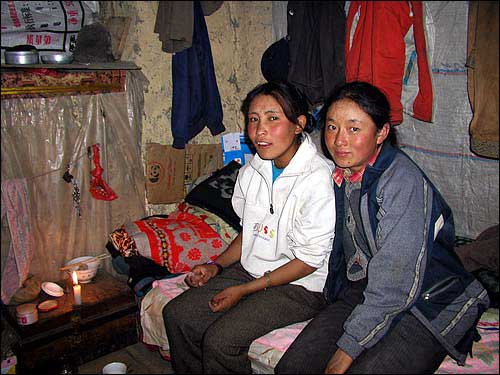Tibetan women turn to prostitution, construction work to stay employed
Tsetang, Tibet ? As the sun rises over this dusty river valley, Yaji tucks her hair under a New York Yankees baseball cap and throws a shovel over her shoulder. From 8 a.m. to 8 p.m., she works on the construction site of a new road on the outskirts of town, mixing cement and moving dirt.
As the sun sets behind rugged mountains scraping the azure Tibetan sky, Qixizhuoma paints her lips a dark amber and pats her cheeks with pink powder. From 8 p.m. to 8 a.m., she works along the banks of the Yarlung River, in the red-light district.
Construction and prostitution are hardly traditional jobs for women in this deeply Buddhist land of sacred mountains and holy lakes. But for the daughters of poor Tibetan farmers hoping to cash in on the economic transformation of their homeland, they are just about the only employment available. Together the young women, in their own way, have helped drive the dramatic makeover of this Tibetan frontier town from a medieval backwater to a modern Chinese city.
“I don’t like it here. I have no other choice,” said Yaji, 18, who like most Tibetans uses one name. “I have two sisters. They need money to go to school.”
Since Chinese settlement of this remote southern Tibetan prefecture of Lhoka intensified in the 1990s, the cradle of Tibetan civilization has taken on the feel of a Himalayan Wild West. Large government subsidies to build roads, bridges and high-rises have lured an estimated 10,000 Chinese migrants to Tsetang alone. Although the majority of the 58,000 people living here are Tibetan, an aggressive cultural invasion threatens to make Tsetang another Lhasa, Tibet’s holiest city, where more than half the population is believed to now be Chinese.
Astonishing growth
The most dramatic change has taken place in Tibet’s rising new cities. Rural poverty drives Tibetan men and women into urban areas in search of jobs. But women face the more daunting challenges as they leave behind a life molded by working in the fields and rudimentary education to compete in a world where Tibetans move ahead only if they are culturally assimilated and fluent in Chinese.
“Wealth is really concentrated in very small sectors of the community, concentrated in urban areas and concentrated in people who work for the government,” said Kate Saunders, a Tibet specialist based in London. “About 85 percent of Tibetans live in rural areas. The majority of Tibetan women are still struggling to survive.”No one knows exactly how many hardscrabble fortune-seekers in Tsetang are Tibetan women from the countryside. “I’d rather be going to school,” Yaji said in halting Chinese as she kicked her shovel into a mound of earth.
Few options amid wealth

Lama, left, and a roommate, both construction workers in Tibet, rent a shack that has no electricity. They decorated their living space with feed bags and packaging materials.
Much as their nomadic ancestors sought greener pastures, here the girls move from construction site to construction site, exchanging manual labor for the equivalent of about $2.50 a day. Although they are among the lowest-paid workers in an industry dominated by Chinese men, the job makes them high earners in a region where the annual income of farmers and herders hovers at just over $200.
“Since April, we made $250,” Yaji said. “I sent it all to my parents.” She did save a little for herself — about half a day’s pay went for her gray baseball cap with the letters “NY” sewn in gold. She doesn’t know where New York is; she’s never even heard of it.
Nima, 36, a Tibetan foreman supervising the construction of a sprawling government building in the middle of town, says there are at least 60 construction sites in Tsetang. Almost all of them hire young Tibetan women to shovel sand, paint walls or scrub new floors. Most are teenagers from rural Tibet who can’t speak Chinese, a basic prerequisite for almost any decent job here. Some start as young as 15, although the foreman insists they must be at least 18.
Shamed sibling
As primitive as their lives seem, the construction girls are the envy of reluctant prostitutes who prowl the night while others sleep. “At least they make an honest living,” said Qixizhuoma, 20, blotting her tears.
She works with five Tibetan girls, some 16 years old. “I’ve become a bad girl. I can’t leave,” Qixizhuoma said.

